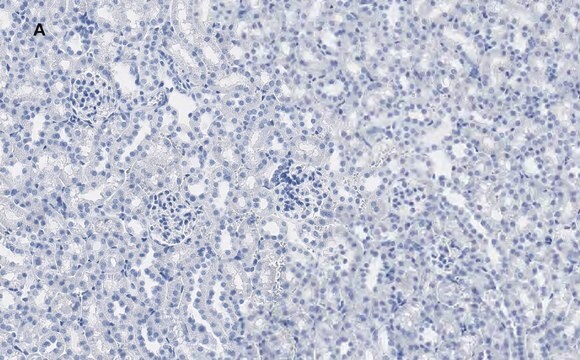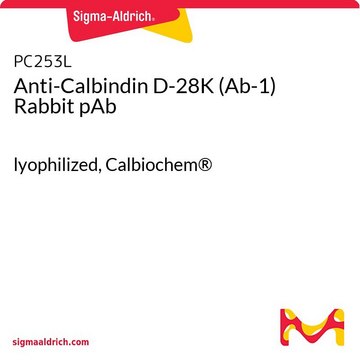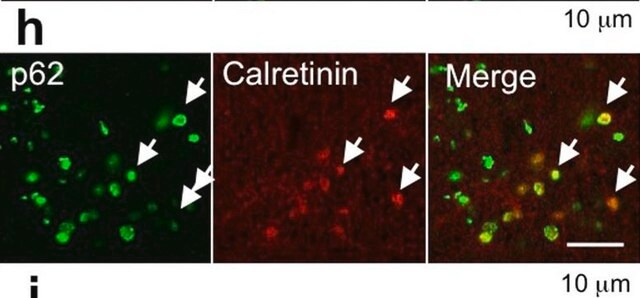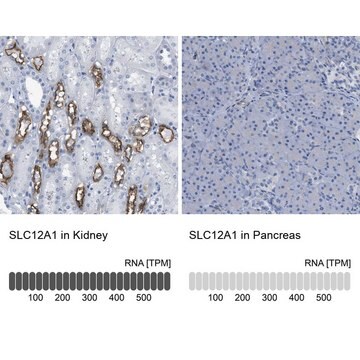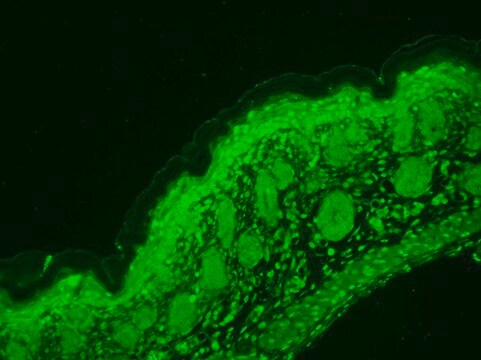Key Documents
C9848
Monoclonal Anti-Calbindin-D-28K antibody produced in mouse

clone CB-955, ascites fluid
Synonim(y):
Calbindin Antibody, Calbindin Antibody - Monoclonal Anti-Calbindin-D-28K antibody produced in mouse
About This Item
Polecane produkty
pochodzenie biologiczne
mouse
Poziom jakości
białko sprzężone
unconjugated
forma przeciwciała
ascites fluid
rodzaj przeciwciała
primary antibodies
klon
CB-955, monoclonal
masa cząsteczkowa
antigen 28 kDa
zawiera
15 mM sodium azide
reaktywność gatunkowa
mouse, human, guinea pig, canine, sheep, rat, pig, rabbit, feline, bovine, goat
rozszerzona walidacja
independent
Learn more about Antibody Enhanced Validation
stężenie
15-55 mg/mL
metody
immunohistochemistry (formalin-fixed, paraffin-embedded sections): 1:3,000 using rat cerebellum sections
indirect ELISA: suitable
western blot: 1:3,000 using MDBK cell extract
izotyp
IgG1
numer dostępu UniProt
Warunki transportu
dry ice
temp. przechowywania
−20°C
docelowa modyfikacja potranslacyjna
unmodified
informacje o genach
human ... CALB1(793)
mouse ... Calb1(12307)
rat ... Calb1(83839)
Powiązane kategorie
Opis ogólny
Monoclonal Anti-Calbindin-D-28K (mouse IgG1 isotype) is derived from the CB-955 hybridoma produced by the fusion of mouse myeloma cells and splenocytes from BALB/c mice immunized with a purified bovine kidney calbindin-D-28K. The isotype is determined by a double diffusion immunoassay using Mouse Monoclonal Antibody Isotyping Reagents, Catalog Number ISO2.
Calbindin-D-28K belongs, together with calmodulin, S-100, parvalbumin, troponin C and other proteins, to a family of low molecular weight calcium-binding proteins (CaBPs). These CaBPs have homologous primary structures, which contain polypeptide folds of the EF-hand type for the acceptance of Ca2+. Calbindin is an attractive neuroanatomical marker. Despite its broad tissue distribution, calbindin-D-28K exhibits a cell-type specific expression pattern. Thus, it has been immunocytochemically localized in selected cells in many CNS structures, where it is thought to act either as an intracellular calcium buffer, or in the intramembranous transport of calcium. It is found predominantly in subpopulations of central and peripheral nervous system neurons, and in certain epithelial cells involved in Ca2+ transport such as distal tubular cells and cortical collecting tubules of the kidney, and in enteric neuroendocrine cells. Monoclonal antibody reacting specifically with calbindin-D-28K is instrumental in the localization of calbindin in different tissues and cell populations.
Specyficzność
Immunogen
Zastosowanie
Działania biochem./fizjol.
Postać fizyczna
Przechowywanie i stabilność
Oświadczenie o zrzeczeniu się odpowiedzialności
Nie możesz znaleźć właściwego produktu?
Wypróbuj nasz Narzędzie selektora produktów.
polecane
Kod klasy składowania
10 - Combustible liquids
Klasa zagrożenia wodnego (WGK)
WGK 1
Certyfikaty analizy (CoA)
Poszukaj Certyfikaty analizy (CoA), wpisując numer partii/serii produktów. Numery serii i partii można znaleźć na etykiecie produktu po słowach „seria” lub „partia”.
Masz już ten produkt?
Dokumenty związane z niedawno zakupionymi produktami zostały zamieszczone w Bibliotece dokumentów.
Klienci oglądali również te produkty
Nasz zespół naukowców ma doświadczenie we wszystkich obszarach badań, w tym w naukach przyrodniczych, materiałoznawstwie, syntezie chemicznej, chromatografii, analityce i wielu innych dziedzinach.
Skontaktuj się z zespołem ds. pomocy technicznej
